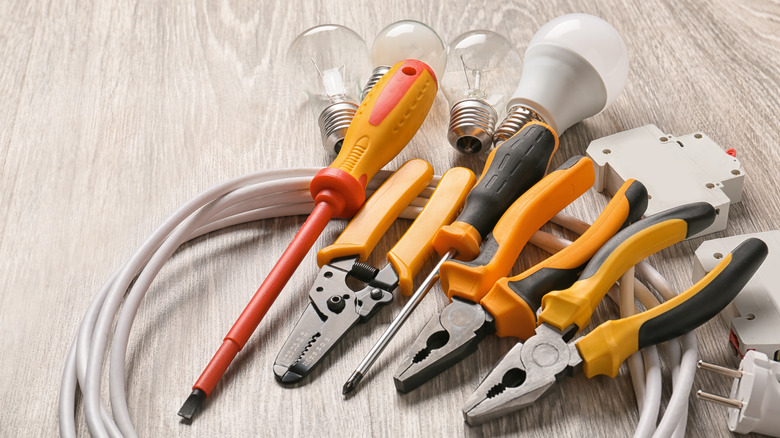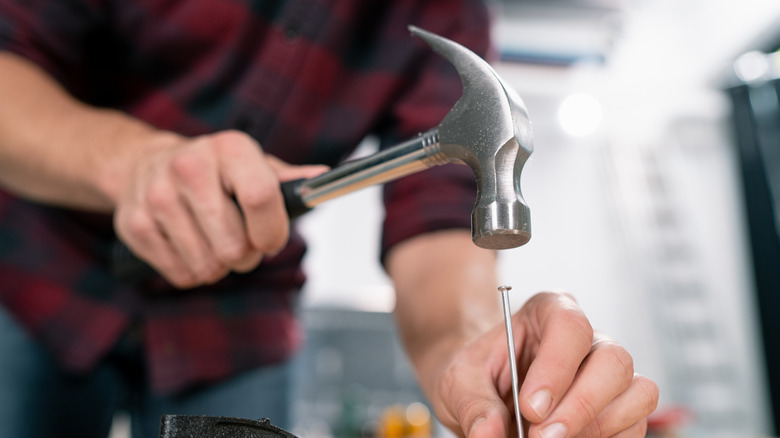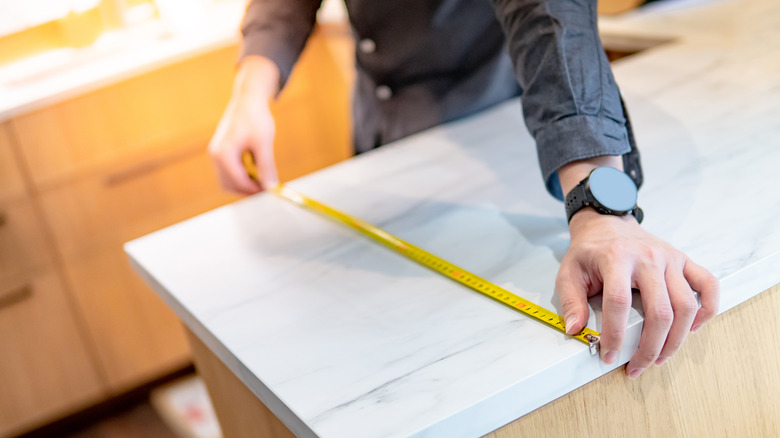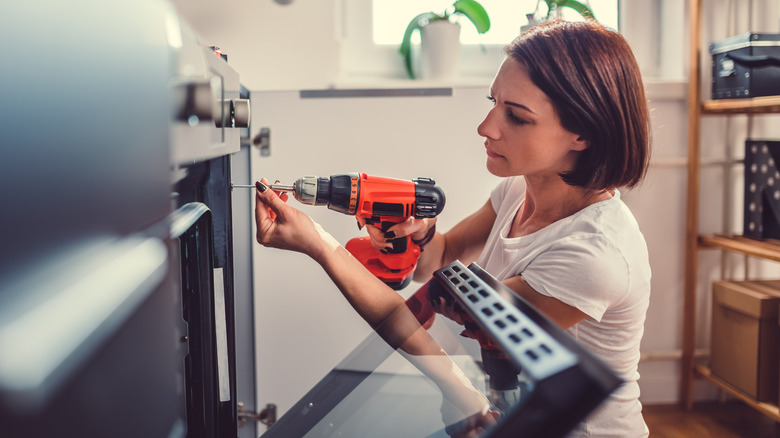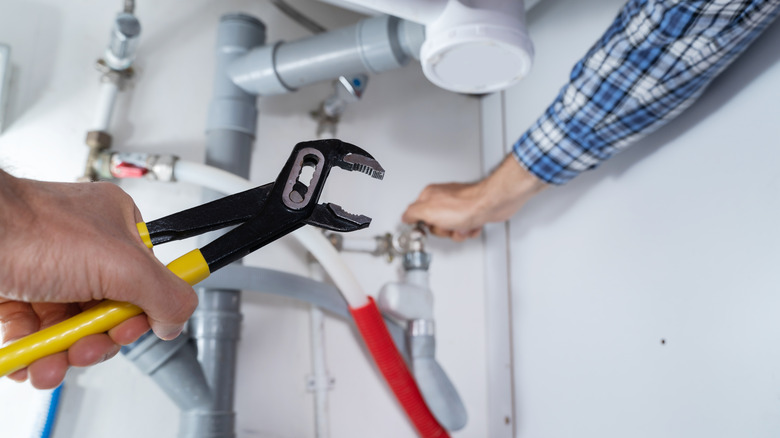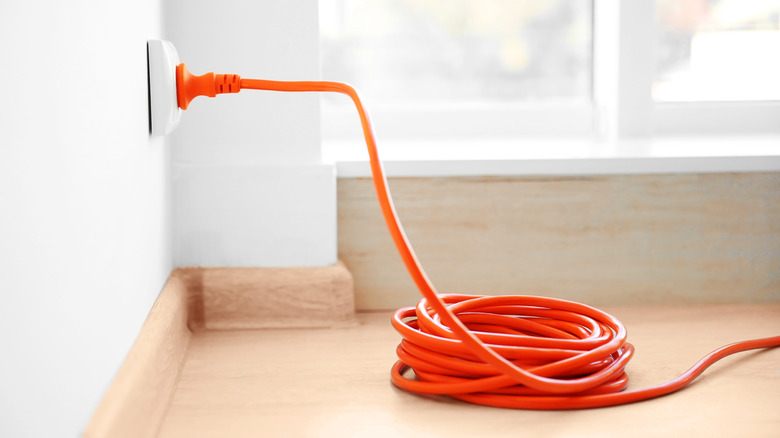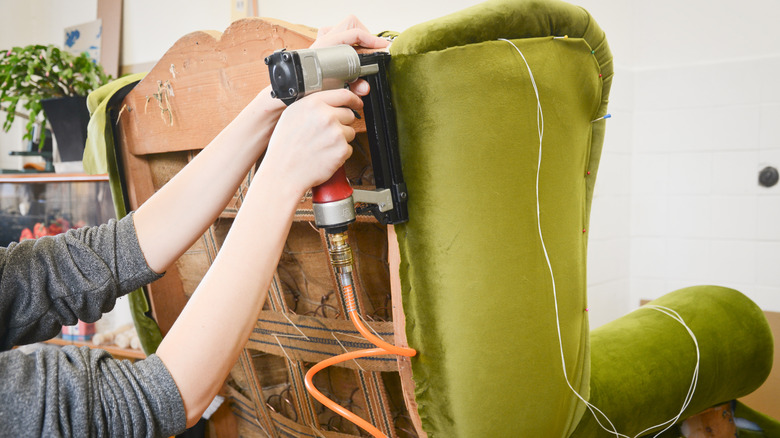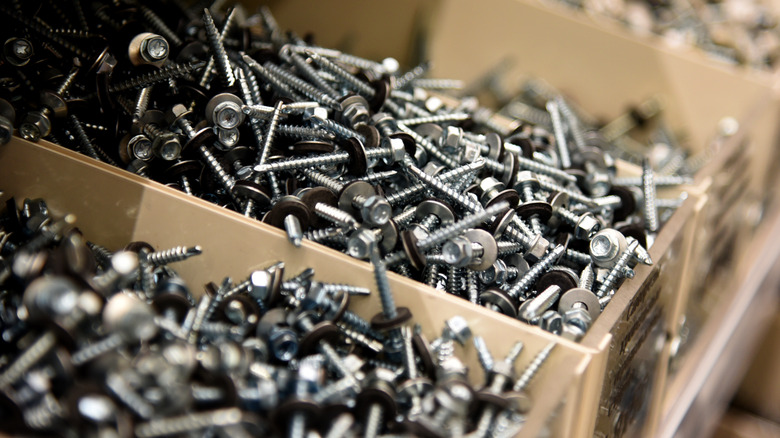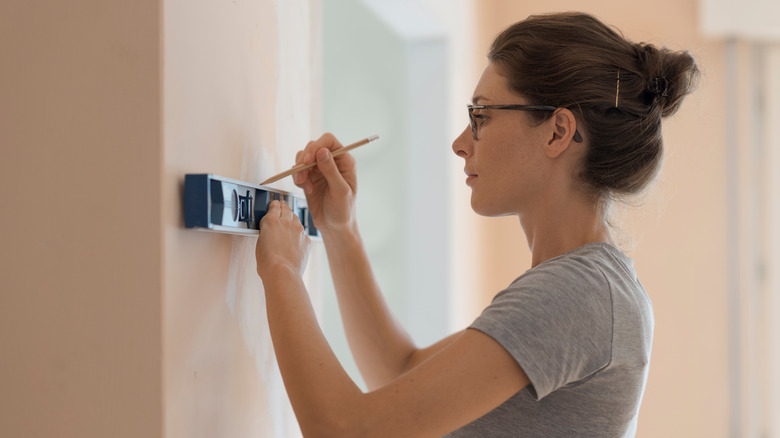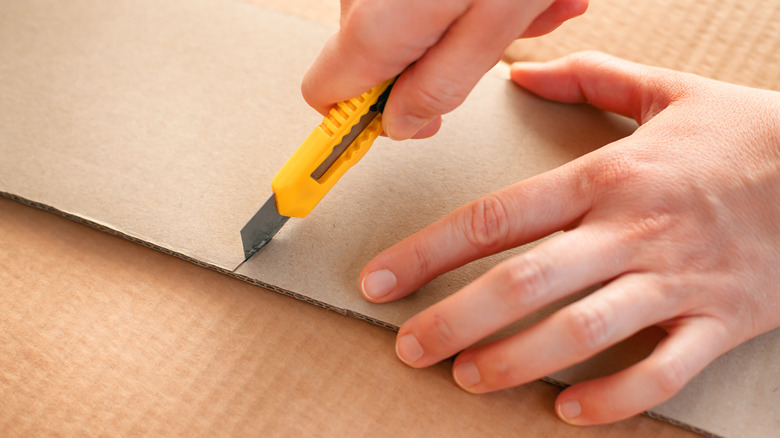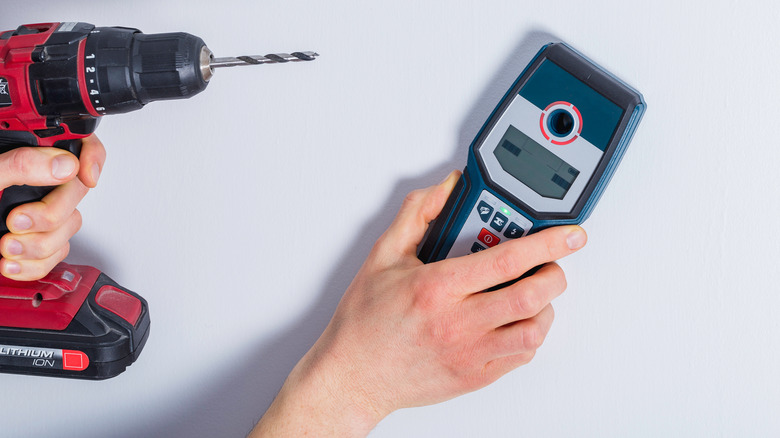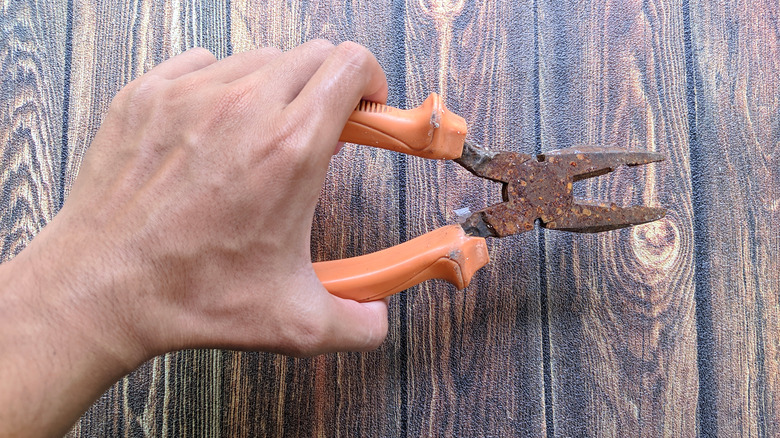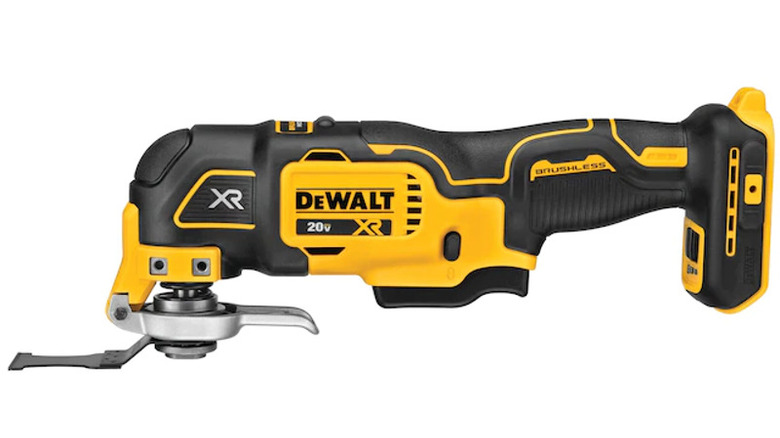Tools Every Homeowner Should Have
Whether you're moving into a new home or simply trying to step up your DIY repair game, there are certain tools that every single homeowner should have. Even if you're the type who tends to call a repairperson to handle most jobs, you'll find that many simple tools are necessary for changing up home decor and accomplishing simple projects that anyone can manage.
Hanging a frame on the wall? You'll likely need a hammer, a nail or two, and a level — to ensure your decor is placed perfectly, of course. Installing a new shelf? A cordless drill, some screws, and a stud finder will definitely come in handy. For nearly every home project or repair, there's a tool (or several) that you should definitely have on-hand.
For those who are investing in a tool kit for the first time, or folks who might be working on a specific project, this list of must-have tools is here to help — no experience necessary.
Hammers for both big and small jobs
If you're just starting to build your toolbox, there are two types of hammers you should have. Though many toolkits only include one hammer, every homeowner is best prepared with two different options: a claw hammer and a ball-peen hammer. They each have different uses, but both can prove invaluable when tackling home repair and DIY projects.
Let's start with the claw hammer. Per Hunker, you'll find that each has a head made of steel. This head is used for both pounding nails and other hardware and extracting them. Because claw hammers are equipped with a V-shape as part of the head, it makes it easy to remove any nails from a surface. The other part of the claw hammer's head is flat — which makes it useful for successfully inserting nails into wood and other materials. According to the same Hunker article, the key to purchasing a claw hammer is paying attention to quality. Typically, the hammers that cost more are made with stronger materials.
In addition to the claw hammer, it's useful to keep a ball-peen hammer on-hand. Per HomeQuicks, ball-peen hammers are on the smaller side — which makes them ideal for working with metal. This type of hammer is obtainable in different sizes, depending on the actual project on which you might be working. If you are making jewelry, you'd want a small ball-peen hammer. If you're working with larger metal pieces, you'll want a larger size.
A screwdriver set is always handy
For any home projects (big or small), a screwdriver set is almost always necessary. And it makes sense, considering just how many different products make use of a screwdriver and its components. Per The Strategist, though, there are a few types of screwdrivers to consider before settling on one.
Want something that does it all? Opt for a screwdriver that comes with replaceable bits. Many screwdriver sets come this way, so it's easy to find (and easy to use). In these sets, you'll get a screwdriver handle on which you can attach and detach different size bits depending on what you need. Usually, that includes Phillips heads and flatheads — standard bit sizes that work with a multitude of screws, according to Strategist.
If you'd rather stick with a singular tool and no extra pieces, though, a flathead or Phillips screwdriver should do the trick. With these, though, you might have a few issues keeping the screwdriver in the screw due to the fact that the sizes might not match up exactly. When using a screwdriver — especially if it has interchangeable bits — make sure that the end of the screwdriver fits tightly inside the screw. According to Hunker, doing so will make sure that the screw won't slide out in the middle of a project.
Be sure to add measuring tape to your at-home tool kit
From preparing your home for new furniture to ensuring the art you just bought will look just right on your wall, measuring tape is absolutely necessary. And though it might seem like an extremely simple tool, there are a few tricks to making the most of your tape measure. According to Bob Vila, the keys to using measuring tape are knowing how to read it correctly and making use of the hook and lock features.
When it comes to reading measuring tape, you'll want to check whether the measurements are in metric or imperial units (or both). Many tape measures in the U.S. offer both the imperial and metric systems. In this case, the imperial measurements are typically in red, while the metric units can be found in black. Keeping this in mind can help you get the most accurate reading possible.
Thankfully, measuring tape usually has a few other features that make the tool simple: a hook and a lock. Per U.S. Tape, you'll almost always find that the blade (the solid piece attached to the end of the tape measure) is curved. Because of this, you can latch the end of measuring tape onto the side of whatever you're measuring — ensuring the tape doesn't bend in the process. To make things even easier still, Bob Vila made sure to note that most tape measures also include a lock button, so you can keep the tape from releasing back into the holder.
A cordless drill makes DIY projects a breeze
A handheld power drill is one of those tools you can't imagine using much — until you have one, and it becomes indispensable. From small home repairs to hanging heavy wall decor, this tool is a must-have.
According to This Old House, one of the best parts of having a cordless drill is the ability to work on projects without having a power outlet nearby. The biggest con is simply the sheer number of cordless drills available. Essentially, it comes down to price. How often will you use the cordless drill? What projects are on your to-do list? Are these projects simple or heavy-duty? Once you gauge how much you really want to invest in a handheld drill, you can move on to looking at other, more specific features.
The main features to look out for are the grip, voltage, and speed-range switch. You want the grip to be comfortable enough to hold for a while — so make sure to test it out before you buy, if possible. The higher the voltage, the more power your cordless drill has. But more voltage can also mean the drill is heavier. In addition to the grip and voltage, make sure you also check the speed-range switch. The high speed is for drilling, while the lower speed is for guiding (or driving) screws. Per This Old House, you want to have an expansive range between high and low.
There's no doubt a wrench set will save you time
When looking for a wrench (or wrenches) to add to your toolbox as a homeowner, size matters. Different fasteners — like bolts and screws — vary in size, and you'll want your wrench to match up just right, in order to avoid any potential harm. Per The Art of Manliness, there are several types of wrenches from which to choose. From adjustable wrenches to socket wrenches, each has its own value. Because of this, opting for a set of wrenches — rather than just one or two — could save you from having to run back and forth to the hardware store.
For instance, an adjustable wrench (also called a crescent wrench) has two "jaws" — one that stays in place and one that can move. With this, you can adjust the size of the wrench depending on how large or small the fastener you're adjusting is. If you put too much pressure on the moveable jaw, though, you risk breaking it. Alternatively, open wrenches and box wrenches are completely fixed. So, the chance you'll damage the wrench is much smaller.
If you're looking for something a bit more efficient for jobs that require a lot of adjusting, you might want to invest in a socket wrench, too. According to Hunker, this type of wrench makes loosening and tightening fasteners easier than other wrenches. For those who don't have much space to move around while working, too, a socket wrench could help solve your problem.
An extension cord is incredibly useful
Whether you're attempting to use a power tool far away from an electrical outlet or simply want to plug in some lights for an outdoor party, an extension cord is a must-have tool that every homeowner should have. The key here, though, is to make sure you're choosing the safest option for your home. You are dealing with a lot of electricity, after all.
Per The Spruce, you typically have three different options when it comes to extension cords: light-duty, medium-duty, and heavy-duty. Depending on what you want to use your cord for, one might work better than another. The light-duty extension cords are best for smaller electrical items. Think table lamps, a clock, or a phone charger. For anything that uses more than seven amps of electricity, you'll want something else.
Larger devices (up to 10 amps) like your television, are best when paired with a medium-duty extension cord. These are typically thicker than light-duty cords and include a space for a third prong in the outlet. Of course, you'll want to switch to a heavy-duty extension cord for anything using 10 to 15 amps. For electric tools (and some appliances), this is the way to go. Depending on how much power you need to complete a project, you're likely safe with heavier duty cords.
Think about getting a staple gun for fastening jobs
When it comes to fabrics, carpet, and insulation, having a staple gun on-hand is so helpful. This tool makes fastening jobs a breeze — and can be worth investing in if you own a home. Per Design Like, there are a few main uses for a staple gun. From putting in carpeting to doing light construction work, this tool has a surprisingly amount of versatility.
If your carpets have started to come up from the floor, you can easily use a staple gun to tack them back down. And the same goes for hardwood and laminate floors, too. Then, move on to any furniture that needs fixing. (Yes, a staple gun works for that!) In addition, you can use a staple gun to secure wood in smaller projects, create DIY frames, or make a birdhouse for your backyard. Rather than using a drill or other heavy-duty tool, a staple gun makes things so much easier.
Of course, you should always make sure to wear protective gear — like goggles — while using a staple gun, according to Tool Nerds. Safety first!
Having a supply of nails, screws, and more is endlessly helpful
Having the right tools as a homeowner means nothing without nails, screws, and more. Keep an assorted supply on-hand in your home, and you'll find that there are infinite ways to use them all — from hanging that new print you just bought to putting together a piece of furniture. If you're tempted to simply buy a set of miscellaneous nails, you might want to rethink that. Or, at the very least, make sure you know what different types of nails do. Per the Home Depot website, some nail types are more common than others — and there are various sizes too. The most common is the aptly named common nail. This type of nail is typically used where sturdiness is key. (It's not particularly pleasant to look at, so you won't want this nail to be seen.) Box nails, brad nails, and finishing nails are three other types you'll see often, too.
Of course, there are also specialty nails — drywall nails, flooring nails, framing nails, and roofing nails — that you might want to have on-hand for specific projects. If you anticipate only using nails for basic repairs and DIY projects, though, you're probably safe with the more common types of nail.
In addition to different nails, make sure you have hooks for hanging pictures (and yes, no-damage options like Command Strips work too), and screws for more heavy-duty ventures. Then, once you've secured a robust collection, the only difficult part is keeping them all organized.
Don't forget about a tool that gives you a step up (literally)
For hard-to-reach places, you likely could use a boost — and a ladder can definitely help give you just that. Depending on how high you need to get in your home, though, the size of the ladder you need might differ. Of course, both tall ladders and step ladders can come in handy for a multitude of projects. Because of this, investing in both can be the best option. Before you decide, though, make sure you're clear on how to use a ladder. It might seem a bit obvious, but ladders can be a safety concern. According to the NASD, there are correct ways to use extension ladders and step ladders.
With extension ladders, make sure you're locking the sides — ensuring the height stays in place. And the highest three steps (or rungs) on a ladder? They're a no-go. Always stand below them. In addition, keep the ladder propped against a structure that cannot move and keep your face toward the ladder when climbing up or down.
Step ladders are a bit easier to keep safe — considering they're lower to the ground — but it's still important to follow all precautions. Don't forget to confirm the step ladder is fully locked in place before stepping on it. And, as is the case with extension ladders, avoid standing on the very top step.
Grab a level to keep things straight
The best way to keep your wall art, mirrors, and shelves from hanging at an angle? Invest in a level. Typically, levels are available in two different iterations: spirit (or sometimes "bubble") levels and laser levels. What you choose to use it up to you, but each has their unique ways of keeping things straight.
The most manual (and common) of the two is the spirit level. According to Hunker, a spirit level features a bubble encased in liquid. You can move this tool around until the bubble is perfectly in the center of the tube — and that's when you know whatever you're hanging is level. A spirit level can be used vertically or horizontally, too, depending on what you're installing.
For a more high-tech leveling experience, you can also opt for a laser level. This type comes in an array of styles — like a laser chalk line level or rotating laser level, per This Old House. Simply put, these levels use a laser to display a perfectly horizontal or vertical line. With this tool, you can easily mark a spot on the wall, or set the laser level on a ladder or tripod to keep the line up while you hang any object.
Buy a utility knife for precision and ease
Save the scissors for your crafting adventures. When it comes to heavy-duty cutting, you can't beat a utility knife. And per Bob Vila, there are so many unexpected ways to use this tool around the house. It requires little-to-no experience, and makes cutting through tough materials a breeze.
Use a utility knife to carve right through carpet — no matter how old it is. (Just make sure you sharpen or replace the blade after, as carpet can dull your knife immediately.) Or, you can trim the edges off a new window frame with ease, cut various types of wood, and even keep your paint job from looking messy by moving the utility knife on the perimeter of painter's tape.
Not to mention, a utility knife is ideal for slicing open boxes and making a simple, precise cut wherever you might need it. From large home projects to small DIYs, a utility knife can always come in handy.
A stud finder makes wall projects easy
A stud finder is an underrated tool that every homeowner should have. But this device can keep you from damaging your walls while trying to hang heavy items. Essentially, a stud finder does exactly what you'd think: finds studs in your wall. Wood studs, per Better Homes & Gardens, serve as part of the foundation of a wall by helping hold up the frame and drywall. And within these studs are nails and screws — the pieces a stud finder can help detect.
When hanging weighty objects on a wall, it's important to have the support of a stud. Rather than drilling or putting a nail directly into drywall — which can cause major damage if the item is too heavy — it's safest to find a stud, according to Bob Vila. Installing a large shelf or oversized wall mirror doesn't have to be so risky, folks. Using a stud finder can give you extra security and keep your mind at ease.
The best part? Stud finders are incredibly easy to use. They typically run on batteries, so you don't have to worry about plugging in the tool. Just hold the stud finder flat against the wall, power it up, and wait for a flash or beeping sound (depending on the specific stud finder you're using). Draw a small mark with a pencil whenever you find a stud, and you're ready to properly hang whatever your heart desires.
Pliers give you a better grip
Pliers are not a one-size-fits-all kind of tool. According to This Old House, there are actually several different types of pliers you should keep in your home. Slip-joint pliers, adjustable pliers, needle-nose pliers, and fencing pliers are all common options — and depending on what you want to do, some are more versatile than others.
For instance, slip-joint pliers are typically used for uncomplicated, lightweight projects. Adjustable pliers do just that — they adjust to whatever object on which you're working. Needle-nose pliers work best when you're in a tight space, and fencing pliers are multi-faceted (with the option to carve, grip, and hammer).
The main use of pliers — per Hunker — is to grip. By keeping items in-place and stable while you work on them, a pair of pliers can make so many jobs easier. In addition to this, though, this tool is commonly used to curve and straighten objects, cut through hardware as tough as nails, and both slice and splice wires. Overall, having at least one pair of pliers in your home can be incredibly handy.
An oscillating multi-tool is as versatile as they come
For trimming, cutting, sanding and more, an oscillating multi-tool is a homeowner's dream. Easier to handle than larger tools, this device can turn big products into manageable ones. According to Pro Tool Reviews, an oscillating multi-tool typically allows a blade, sander, or scraper (depending on which attachment you're using) to move quickly in different directions. And, as an added bonus, this device works especially well in smaller spaces. Compact and versatile? It's a win-win.
If you're trying to decide which accessories to add to your multi-tool, Family Handyman has some ideas. Opt for a straightedge, round and straight blades, bimetal blade, and scraper blades. And per Pro Tool Reviews, you also have the option to add a sanding attachment — perfect for smaller projects with a lot of detail. With these accessories, you can tackle an endless number of home projects without much hassle. For everything from getting rid of grout to actually cutting through metal (yes, really), a multi-tool has the potential to become the star of your toolbox.
